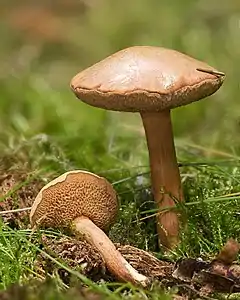Chalciporus
Chalciporus is a genus of fungi in the family Boletaceae (suborder Boletineae).[1] There are approximately 25 species in the genus.[2]
| Chalciporus | |
|---|---|
 | |
| Chalciporus piperatus | |
| Scientific classification | |
| Kingdom: | |
| Division: | |
| Class: | |
| Order: | |
| Family: | |
| Genus: | Chalciporus Bataille (1908) |
| Type species | |
| Chalciporus piperatus | |
| Species | |
|
28 species | |
French mycologist Frédéric Bataille erected the genus in 1908, though it did not gain general acceptance for several decades and was often classified as a section (Piperati) of the genus Suillus or related to the genus Pulveroboletus. The type species is Chalciporus piperatus.[3] Rolf Singer resurrected the genus in 1973, separating the species from the genus Suillus on the basis of distinct pigments.[4] The name is derived from the Ancient Greek khalkos "copper",[5] and translates as "copper pores".[6]
The genus Chalciporus, together with the genus Buchwaldoboletus form a group of fungi that is an early offshoot in the Boletaceae. Many members of the group appear to be parasitic.[7] Wu and Yang proposed that this clade be called the subfamily Chalciporoideae.[8] The genus Rubinoboletus was merged into this genus based on their morphological similarity,[9] and subsequent genetic analysis—mainly due to Rubinoboletus (now Chalciporus) rubinus being nested within Chalciporus.[3][8]
Members of the genus Chalciporus have boletoid fruit bodies with pores that are various shades of red to pink, stipes lacking in reticulations, yellow mycelium and smooth oval spores.[3]
Two species, C. chontae and C. radiatus, have pores that are arranged in furrows that radiate out from the top of the stipe under the cap and resemble gills.[3]
C. piperatus and C. piperatoides are peppery-tasting, the former is edible while the latter is unknown. C. rubinellus and C. pseudorubinellus are milder-tasting and edible.[6]
Species
- Chalciporus africanus
- Chalciporus amarellus
- Chalciporus aurantiacus
- Chalciporus cervinococcineus
- Chalciporus chontae — Costa Rica
- Chalciporus griseus
- Chalciporus luteopurpureus
- Chalciporus phaseolisporus
- Chalciporus phlebopoides
- Chalciporus pierrhuguesii
- Chalciporus piperatoides
- Chalciporus piperatus
- Chalciporus piperolamellatus
- Chalciporus pseudorubinellus — Colombia
- Chalciporus radiatus — southern China
- Chalciporus rubinellus
- Chalciporus rubinus
- Chalciporus subflammeus
- Chalciporus virescens
References
- Binder M, Hibbett DS (2006). "Molecular systematics and biological diversification of Boletales". Mycologia. 98 (6): 971–81. doi:10.3852/mycologia.98.6.971. PMID 17486973.
- Kirk PM, Cannon PF, Minter DW, Stalpers JA (2008). Dictionary of the Fungi (10th ed.). Wallingford: CAB International. p. 134. ISBN 0-85199-826-7.
- Zhang M, Wang C-Q, Li T-H, Song B (1 September 2015). "A new species of Chalciporus (Boletaceae, Boletales) with strongly radially arranged pores". Mycoscience. 57: 20–25. doi:10.1016/j.myc.2015.07.004.
- Singer R (1973). "Notes on bolete taxonomy". Persoonia. 7 (2): 313–20.
- Liddell HG, Scott R (1980). A Greek-English Lexicon (Abridged Edition). United Kingdom: Oxford University Press. p. 776. ISBN 0-19-910207-4.
- Bessette AR, Bessette A, Roody WC (2000). North American Boletes: A Color Guide to the Fleshy Pored Mushrooms. Syracuse: Syracuse University Press. pp. 172–75. ISBN 0-8156-0588-9.
- Nuhn ME, Binder M, Taylor AFS, Halling RE, Hibbett DS (2013). "Phylogenetic overview of the Boletineae". Fungal Biology. 117 (7–8): 479–511. doi:10.1016/j.funbio.2013.04.008. PMID 23931115.
- Wu G, Feng B, Xu J, Zhu X-T, Li Y-C, Zeng N-K, Hosen MI, Yang ZL (2014). "Molecular phylogenetic analyses redefine seven major clades and reveal 22 new generic clades in the fungal family Boletaceae". Fungal Diversity. 69 (1): 93–115. doi:10.1007/s13225-014-0283-8.
- Klofac W, Krisai-Greilhuber I (2006). "Die Gattung Chalciporus, ein weltweiter Überblick" [The genus Chalciporus, a world-wide survey] (PDF). Österreichische Zeitschrift für Pilzkunde. 15: 31–65.